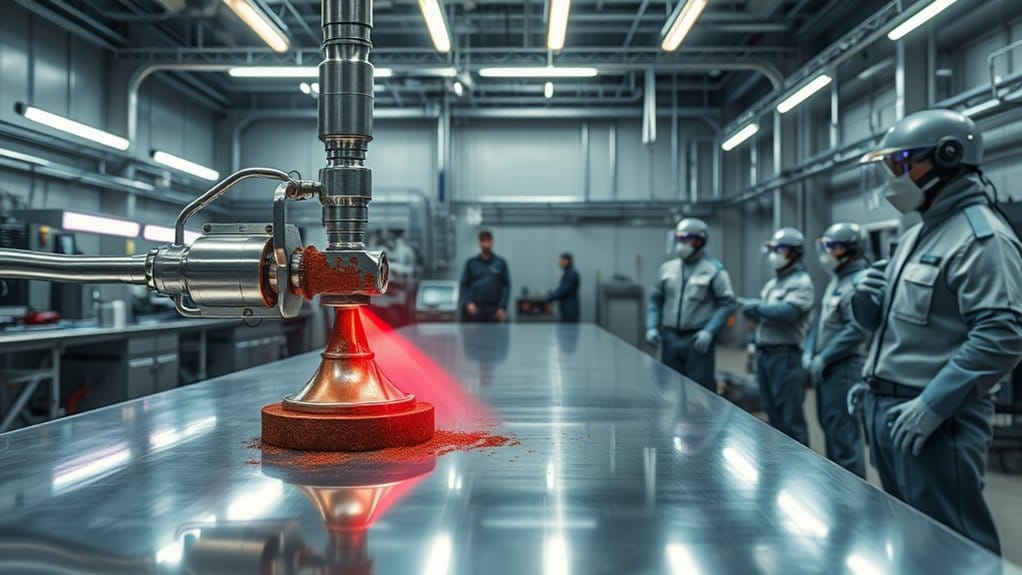The future of cleaning is being shaped by laser technology, a field in which Laser Cleaning Portugal is leading the way with precision, efficiency, and eco-friendliness.
The industry has witnessed significant growth, with the market expanding from $589 million in 2018 to an anticipated $4.1 billion by 2032, thanks to advancements in fiber laser technology and AI integration.
At Laser Cleaning Portugal, we are committed to eliminating harmful chemicals, enhancing safety, and meeting environmental regulations, which positions us as pioneers of sustainable cleaning solutions.
Our collaborations with industry leaders in construction, inspection, and manufacturing, along with partnerships with local educational institutions, ensure that Laser Cleaning Portugal remains at the forefront of laser-based technology.
This allows us to provide unmatched services across Portugal. Emerging trends point to significant efficiency improvements and expanded applications across various sectors, and there’s much more unfolding in this innovative space.
Key Takeaways
- Laser cleaning technology offers eco-friendly, chemical-free solutions, aligning with environmental regulations and supporting green manufacturing practices.
- Advancements in fiber laser technology enhance system efficiency, making laser cleaning more compact and energy-efficient.
- AI integration optimizes laser path planning, improving operational efficiency and ensuring consistent quality through real-time monitoring.
- Market growth is driven by increasing demand for sustainable cleaning alternatives, with projections reaching $4.1 billion by 2032.
- Laser cleaning preserves historical artifacts, reducing maintenance downtime without damaging delicate surfaces, crucial for cultural conservation.
Overview of Laser Cleaning Technology
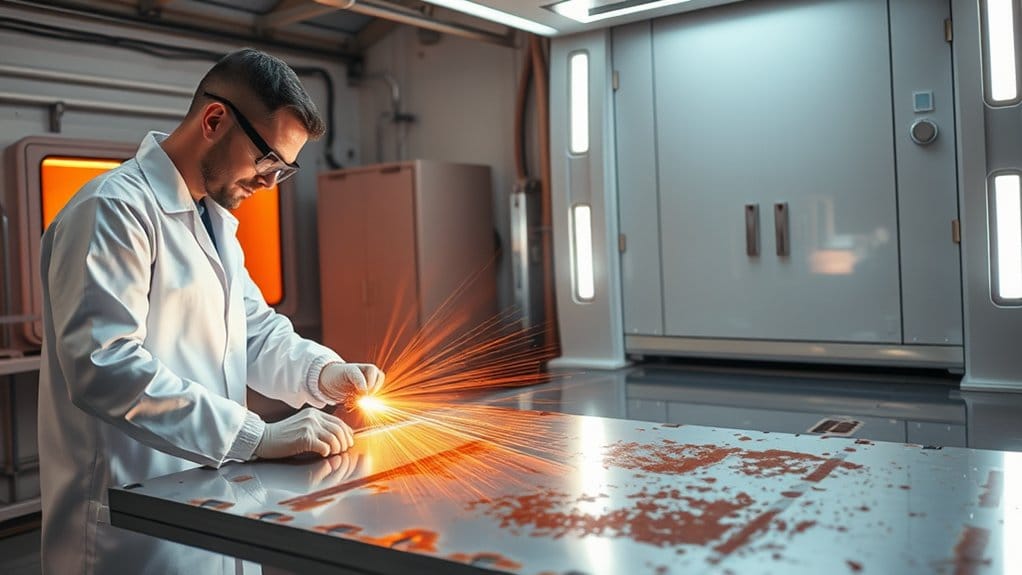
Laser cleaning technology revolutionizes surface maintenance with its precision and efficiency. By utilizing short bursts of laser light, we can precisely ablate unwanted materials like rust and dirt without harming the underlying surface. This method supports sustainable cleaning, as it eliminates the need for harmful chemicals, enhancing workplace safety and aligning with environmental goals. The market’s impressive growth, from $589 million in 2018 to a projected $724 million by 2023, reflects a 4.22% CAGR, highlighting its increasing adoption. Fiber laser cleaners, essential in large-scale production, efficiently remove contaminants and maintain precision. Recent advancements, such as portable systems, make this technology accessible for small and medium-sized businesses, offering a powerful tool for sustainable and efficient cleaning solutions.
Mechanisms of Laser Ablation
Building on the impressive growth and applications highlighted earlier, understanding the mechanisms of laser ablation reveals why it’s a game changer in the cleaning industry. Laser technology uses short bursts of light precisely aimed at surface materials, allowing laser cleaning systems to remove rust, paint, or dirt without damaging the substrate. This precision stems from the principle that materials absorb laser energy at different rates, ensuring targeted cleaning while shielding adjacent areas. By leveraging various laser wavelengths, these systems optimize ablation for specific materials and contaminants. The precision and speed of laser ablation drastically reduce maintenance downtime, offering significant efficiency gains. Additionally, advances in fiber laser technology have made these systems more compact and energy-efficient, further enhancing their appeal for industrial applications.
Environmental and Safety Advantages

As industries increasingly prioritize sustainability, the environmental and safety advantages of laser cleaning technology become more apparent. This eco-friendly, chemical-free process revolutionizes how we think about cleaning solutions, aligning perfectly with stringent environmental regulations. By eliminating hazardous chemicals, we not only reduce the risk of contamination but also greatly enhance workplace safety for operators. This approach minimizes health risks and supports green manufacturing practices, vital for businesses striving for freedom from pollution. Additionally, laser cleaning is non-invasive, protecting delicate materials and historical artifacts from damage. As the market grows, driven by these regulatory pressures, laser cleaning stands out as the preferred choice for manufacturers. It’s a step toward a cleaner, safer world that meets changing sustainability goals.
Efficiency and Precision in Cleaning
When we investigate the efficiency and precision offered by laser cleaning technology, it becomes clear why industries are rapidly adopting this method. Laser cleaning provides unparalleled precision, targeting contaminants like rust and paint without harming delicate surfaces or complex structures. We’ve seen it reduce maintenance downtime considerably, outperforming traditional methods, especially in high-accuracy sectors like aerospace and automotive.
With AI algorithms optimizing path planning, operational efficiency is enhanced by minimizing unnecessary movements, cutting down process time. Real-time monitoring allows for immediate detection and correction of defects, enhancing accuracy and reducing errors. As industries seek eco-friendly solutions, laser cleaning’s chemical-free process aligns with sustainability goals. This combination of efficiency, precision, and environmental responsibility positions laser cleaning as a revolutionary force in the cleaning industry.
Versatility Across Various Industries
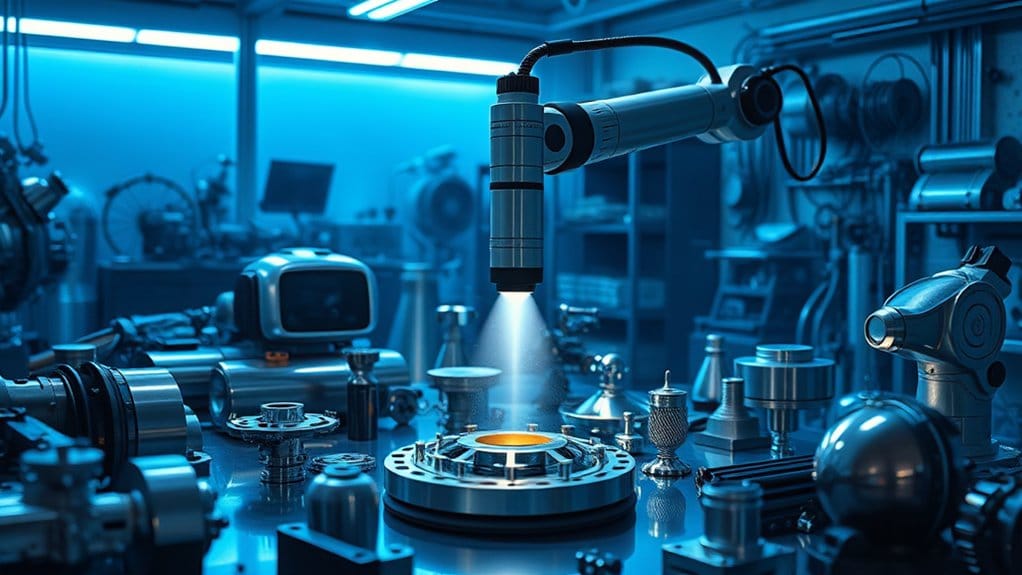
Although laser cleaning technology initially gained traction for its precision and efficiency, its versatility across various industries truly highlights its revolutionary potential. Laser cleaning machines have proven effective on materials like metals, plastics, ceramics, and stone, making them indispensable across sectors such as aerospace, automotive, and art restoration. Industrial maintenance benefits from their adaptability in mold cleaning, surface treatment, and rust removal. In cultural heritage, lasers preserve historical artifacts by removing contaminants delicately. The global market, valued at $589 million in 2018, is projected to reach $724 million by 2023, underscoring growing demand. Furthermore, the development of smaller, portable systems will expand access to laser cleaning technologies, enabling smaller businesses and niche sectors with state-of-the-art, adaptable solutions.
Historical Applications and Significance
Let’s consider the impact of laser cleaning technology on cultural relic conservation, particularly in Europe since the mid-1990s. Data shows that this method has effectively preserved historical artifacts by removing harmful substances without damaging the underlying materials, an essential factor in maintaining the integrity of ancient sites like churches and castles. By integrating laser cleaning into restoration practices, we’ve not only enhanced the quality and precision of artifact preservation but also guaranteed that these cultural treasures endure for future generations.
Cultural Relic Conservation
Since the mid-1990s, laser cleaning has revolutionized the conservation of cultural relics in Europe, demonstrating its indispensable role in preserving historical artifacts and ancient structures. This precise cleaning method stands out in the field of industrial cleaning for its ability to remove contaminants like paint and rust without harming delicate surfaces. Unlike traditional methods, laser cleaning allows us to protect the integrity of antiques and historical relics. Notable applications include:
- Churches and castles: Safeguarding architectural heritage.
- Universities and museums: Preserving educational and cultural institutions.
- Sculptures: Maintaining artistic legacies.
As technology advances, research is refining laser parameters to enhance its effectiveness. This evolution equips us to conserve culturally significant artifacts with precision, ensuring their stories continue to inspire future generations.
European Restoration Practices
European restoration practices have employed laser cleaning technology to alter the preservation of cultural heritage, marking nearly three decades of substantial progress. Since the mid-1990s, this cleaning technology has been welcomed for its precision in removing contaminants like paint and rust without compromising delicate surfaces. This approach has become a cornerstone in the laser cleaning market, enhancing the restoration of ancient buildings and artworks across Europe.
Our commitment to preserving these treasures has seen laser cleaning applied in numerous heritage sites such as churches, castles, and museums. The high fidelity and cleanliness achieved are unmatched, maintaining the integrity and authenticity of historical objects. Europe’s leadership in these practices showcases a pioneering spirit in cultural conservation, offering a vision of freedom through preservation and innovation.
Historical Artifact Preservation
When considering the preservation of historical artifacts, laser cleaning technology emerges as an indispensable tool for maintaining cultural heritage integrity. Since the mid-1990s, we’ve seen it extensively used in Europe for restoring and decontaminating cultural relics, ensuring these treasures remain undamaged. The precision of laser cleaning allows us to target specific layers, removing paint, rust, and contaminants without harming the underlying surfaces. This method has been employed in prestigious locations like:
- Churches and castles, where the conservation of intricate details is essential.
- Universities and museums, offering sustainable restoration practices.
- Sculptures, allowing for precise cleaning without harsh chemicals.
Current Developments in Laser Cleaning

As the laser cleaning industry continues to evolve, extraordinary developments are reshaping its environment. Technology advancements are driving market behavior, with fiber lasers leading the charge. These compact, energy-efficient systems are gaining traction in sectors like manufacturing and automotive, offering an effective, non-damaging cleaning solution. The demand is further fueled by strict environmental regulations, pushing for pollution-free alternatives.
| Industry | Technology Used | Benefits |
|---|---|---|
| Manufacturing | Fiber lasers | Non-damaging, efficient |
| Shipbuilding | Fiber lasers | Surface preparation, eco-friendly |
| Cultural Heritage | Fiber lasers | Preservation, contaminant removal |
| Automotive | Fiber lasers | Efficiency, reduced maintenance |
Additionally, AI integration optimizes laser operations with predictive maintenance and real-time monitoring. These innovations not only enhance efficiency but also align with a growing market enthusiastic for cleaner, greener solutions.
Market Growth and Future Prospects
As we examine the projected expansion of the laser cleaning market, we’re seeing an impressive growth path from $724 million in 2023 to an anticipated $4.1 billion by 2032, fueled by a CAGR of 7.5%. This growth is driven by emerging trends like the demand for eco-friendly cleaning solutions and advancements in fiber laser technology, which enhance system efficiency and precision. With North America currently leading and the Asia-Pacific region rapidly catching up, we can expect significant shifts in the industry’s environment over the next decade.
Projected Market Expansion
The laser cleaning market is on a significant growth course, projected to expand from approximately $2.1 billion in 2023 to an estimated $4.1 billion by 2032, with a compound annual growth rate of around 7.5%. This projected market expansion is expected to experience significant momentum due to several factors:
- Technological Advancements: Investments in automation and laser technologies are enhancing efficiency.
- Regional Market Leaders: North America’s advanced infrastructure and consumer demand drive leadership.
- Asia-Pacific Growth: Urbanization and rising incomes spur rapid expansion.
We’re witnessing an industry shift fueled by increased regulation and environmental awareness, pushing sustainable methods to the forefront. As we explore deeper into laser cleaning’s potential, these factors underscore a promising path for the industry’s future, granting us the freedom to innovate and evolve.
Emerging Industry Trends
While the laser cleaning industry continues its upward path, emerging trends are shaping its market growth and future prospects. Significant growth is expected, with the market projected to double from $2.1 billion in 2023 to $4.1 billion by 2032, driven by a 7.5% CAGR. Key factors include increased automation investments and advanced laser technologies enhancing efficiency. The shift towards environmentally friendly solutions is essential, as laser cleaning eliminates harmful chemicals, aligning with global pollution reduction efforts. North America remains a powerhouse, thanks to its technological infrastructure and consumer demand. Meanwhile, the Asia-Pacific region is rapidly emerging due to urbanization and rising disposable incomes, suggesting a vibrant future for laser cleaning technologies. Embracing these trends can facilitate unparalleled freedom in cleaning solutions.
Challenges in the Industry
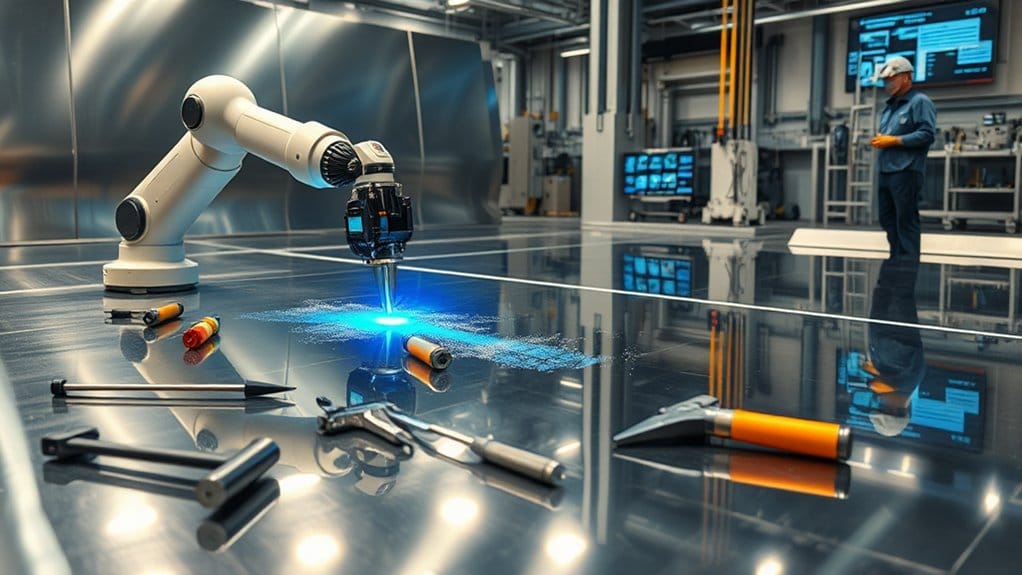
Though laser cleaning holds immense potential, several challenges impede its advancement within the industry. Market research reports highlight key obstacles that must be addressed to reveal the full benefits of this technology. In China, domestic technology and industrialization lag behind foreign competitors, affecting competitiveness. Additionally, the industry lacks a mature system for applications, despite numerous market opportunities. Without standardized testing methods and industry standards, growth and consistency remain elusive.
To address these issues, we must focus on:
- Collaborative efforts among research institutes, production enterprises, and application units
- Establishing standardized testing methods and instruments
- Developing industry standards for consistent practices
As the market expands, overcoming these challenges in the industry will be essential for utilizing laser cleaning’s potential.
Role of AI in Enhancing Laser Cleaning
Addressing the challenges in laser cleaning demands innovative solutions, and AI offers a promising avenue for overcoming these obstacles. By optimizing path planning, AI algorithms guarantee we experience significant growth in efficiency, reducing unnecessary movements and processing time. With automation, we integrate robotic systems, enhancing speed and precision while minimizing human intervention, which elevates productivity. Real-time monitoring systems collect and analyze data, detecting defects instantly and allowing for immediate adjustments, thereby improving accuracy and reducing errors. Additionally, AI-driven quality control systems identify imperfections that human inspections might miss, guaranteeing consistent quality across applications. Predictive maintenance capabilities anticipate equipment needs, reducing downtime and maintaining peak operational efficiency. Through AI, laser cleaning becomes a more resilient, reliable, and productive technology.
Emerging Trends and Innovations
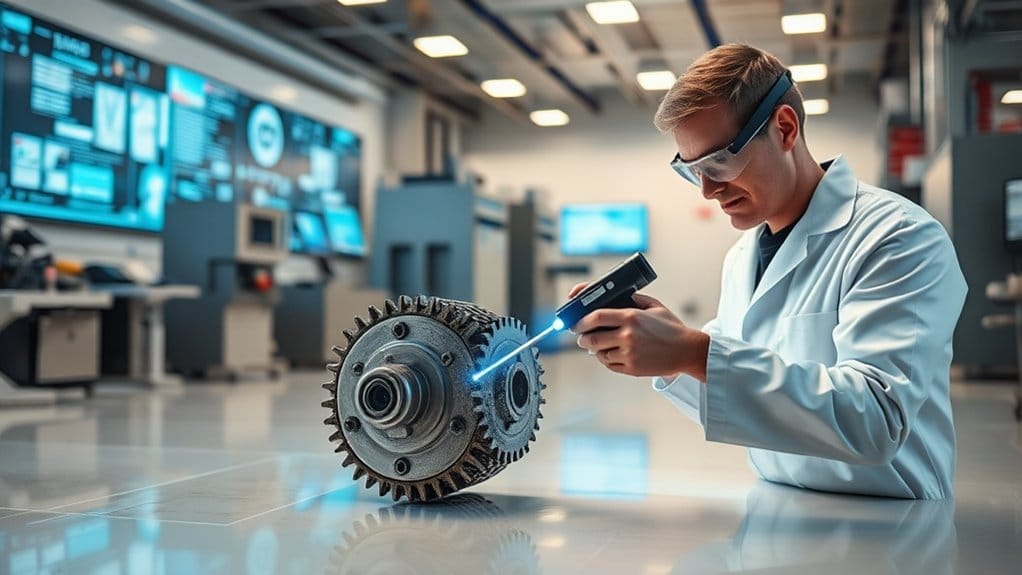
As we investigate the emerging trends and innovations in laser cleaning, it’s clear that this technology is on the brink of revolutionary growth. The global market is projected to rise from $589 million in 2018 to $724 million by 2023, with a CAGR of 4.22%. Key drivers include:
- Fiber laser technology: Compact and energy-efficient, it removes contaminants without damaging materials.
- Stricter environmental regulations: Demand is fueled by a need for pollution-free, solvent-free cleaning.
- Automation and AI advancements: Real-time monitoring and predictive maintenance enhance efficiency.
Laser cleaning’s adoption is expanding into aerospace, automotive, and cultural heritage sectors. By prioritizing sustainability, businesses can utilize these innovations to achieve cleaner operations with minimal environmental impact, aligning with a vision of freedom and responsibility.
Conclusion
At Laser Cleaning Portugal, we stand at the forefront of sustainable cleaning solutions, poised to revolutionize the industry with our cutting-edge laser cleaning technology. Did you know that the laser cleaning market is projected to grow at a CAGR of over 4% by 2028? This growth underscores the technology’s efficiency, precision, and environmental benefits. By integrating AI, Laser Cleaning Portugal is ready to enhance these capabilities even further, addressing current challenges and revealing new possibilities across diverse industries. Our strategic partnerships with industry leaders in construction, inspection, and manufacturing, along with our collaboration with local educational institutions, ensure that we remain ahead in laser-based technology. The future is bright for laser cleaning, and Laser Cleaning Portugal is proud to provide unmatched services across Portugal.

